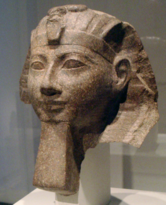
Ancient Egyptian Wigs
Whether you're a kid, teacher, homeschooler, a student looking for homework help, a hairdresser, or just a curious fact-lover, we think you'll find this information fascinating!
Let's start off with the basics.
1. What were Egyptian wigs made of?
For the middle class, particularly those who couldn’t afford wigs made completely out of human hair, they would purchase a blended wig, which was constructed of part human hair, part vegetable fibers.
Wigs could also be made of sheep’s wool.
The absolute cheapest wigs were made out of 100% vegetable fibers.
2. Who could wear wigs, and who couldn’t?
Children did not wear wigs. Instead, girls either braided their hair or wore pigtails, and boys often sported shaved heads. Some kids wore what's called a side-lock, which was a braid on one side.
Priests, also, did not generally wear wigs and preferred to shave their heads instead.
Slaves and servants were prohibited by law from wearing wigs. They weren’t even allowed to shave their heads.
3. Why did Egyptians wear wigs?
- Decoration. People liked the way wigs looked.
- Shade. Given that wigs could often be quite large and thick, the hairpieces could have acted as sun hats. They would have offered a degree of shade.
- Special occasions and religious ceremonies. People would pull out their most expensive wigs for these occasions, rather than wear the simpler wigs they wore for everyday use.
- To cover thinning hair. Even back then, people were concerned about hair loss. We know this because archaeologists have found instructions and recipes for hair growth remedies.
Boil up the paw of a female greyhound, the stone of a date, and the hoof of an ass.
4. What color were Egyptian wigs?
Queen Nefertiti, however, bucked both of these trends and had a fondness for dark blue wigs, which she made famous. What a fashion-forward rebel!
5. How were wigs decorated?
- golden tubes
- jewelry chains
- glittery pins and clips
- ribbons woven through braids
- tassels
- flowers
- tiaras
- colored strands
- caps
- headbands
6. How were wigs made from human hair?
 |
Walters Art Museum |
After cleaning the hair, it was separated into various lengths. A wigmaker would coat the hair with a mix of resin and beeswax to make it easier to work with.
Hairdressers would then weave the hair through a cap made of fine netting (which itself was often made of hair) and affix the strands using more wax.
After creating the basic wig, styles would be applied such as braids and curls. The wax and resin would help keep the styles in place through endless wearings, even in the Egyptian heat.
Fun fact: One particularly impressive wig artifact contains 120,000 individual hairs!
7. Who made wigs?
Barbers also made wigs, and so did women. It was considered a very respectable profession.
8. How were wigs cared for?
Since they couldn’t be washed, wigs would be perfumed instead using scented petals, essential oils, and wood chips such as cinnamon bark.
Oils and emollients made from animal or vegetable fats could be applied to keep the wigs shiny and supple.
9. What the heck is a beard wig?
 |
| Pharaoh Hatshepsut - Berlin Museum Keith Schengili-Roberts |
Beard wigs were braided and knotted into a tight, solid rectangle or tube shape that hung straight down from the chin. They became so popular that even the gods were depicted wearing beard wigs.
Beard wigs became a symbol of pharaonic power, worn to show that they were living gods on earth. Even some of Egypt’s queens, such as Pharaoh Hatshepsut, wore beard wigs during certain ceremonies for this purpose.
10. How did wig styles change?
Old Kingdom wigs: These were short and either straight or with rows of short overlapping curls.
 |
Louvre - Guillaume Blanchard
New Kingdom Wigs: Many people wore wigs with groupings of long, tassel-ended tails. Women’s wigs became even larger and bulkier, and decorations became hugely popular, including beads and ribbons, and fancy caps. Men preferred less bulky wigs, and ones that were longer in the front than in the back.
Amarna Period Wigs: During this time, styles became short and simple.
A final note:
I hope you have enjoyed this article about Egyptian wigs.
Are you interested in learning more about ancient Egyptian grooming techniques?
Did you know their lipstick made them sick?
Thank you for sharing!









